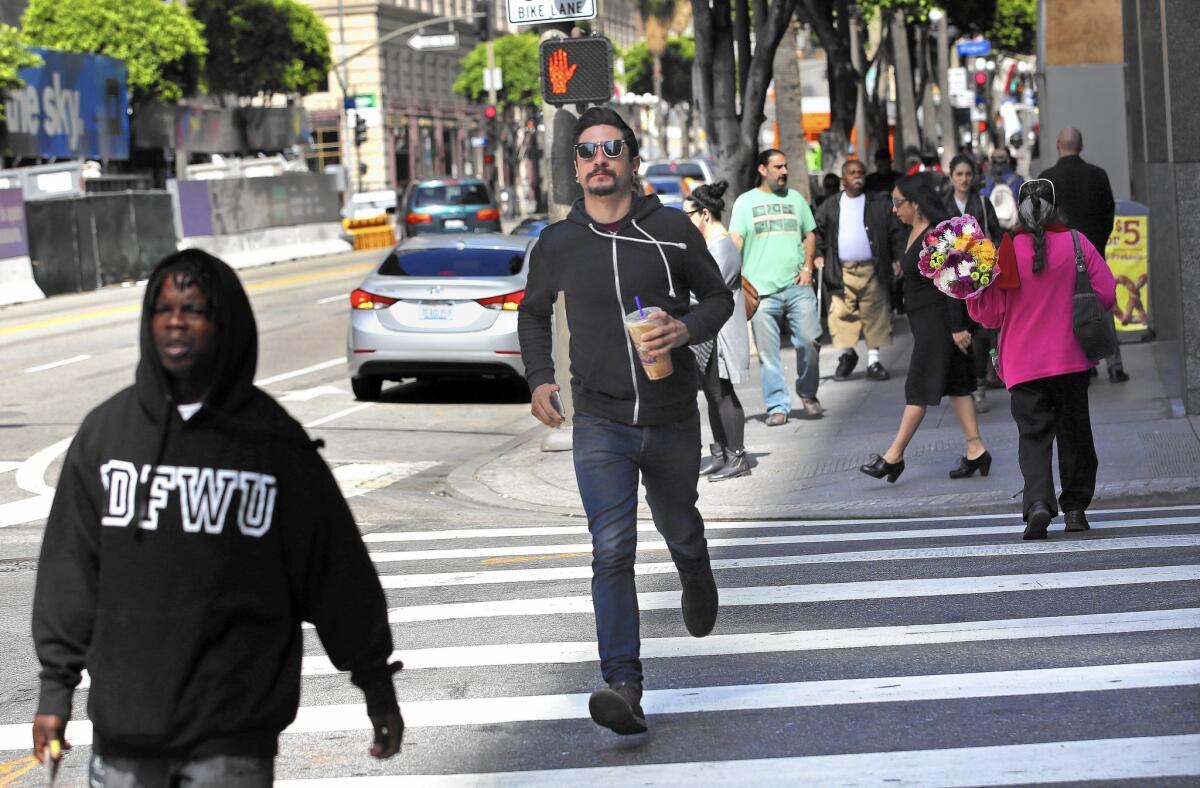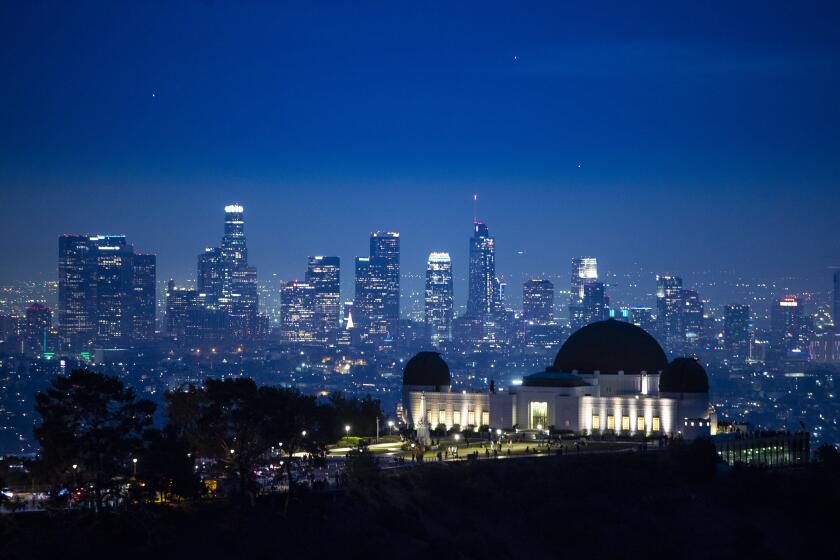For downtown L.A.’s pedestrians, citations send a ‘don’t walk’ signal

Some of the newer residents of downtown are unhappy with the LAPD’s traffic enforcement -- don’t think you won’t get a ticket if you enter the crosswalk after the red hand starts flashing and the countdown has begun -- and they have tickets to prove it.
- Share via
The raised red hand flashes as Eduardo Lopez darts into the crosswalk outside L.A.’s 7th Street Metro station.
In one fluid movement, Los Angeles Police Officer Robert Lockhart fires up his black and white motorcycle and rumbles across Hope Street toward the 22-year-old college student, initiating a confrontation — a symbol, perhaps, of emerging tensions as the balance of power between walkers and drivers shifts in L.A.’s newly revitalized downtown.
Lopez says he was running for a bus to make his first class at Glendale Community College and didn’t hear Lockhart’s order: “Don’t go.”
Unmoved, Lockhart hands him a $197 ticket.
Over the next two hours, Lockhart will write up at least eight more pedestrians who violate “21456” — cop-speak for the vehicle code section that makes it illegal to step into a crosswalk after the red hand starts flashing and the countdown has begun.
Lockhart is unapologetic about his unpopular role.
But as gleaming new condominium and apartment buildings replace parking lots, L.A.’s streets swarm with pedestrians who increasingly refuse to accept a subordinate role to the automobiles that have traditionally ruled L.A. And some of these urban pioneers say the city’s vigorous enforcement of pedestrian laws is just another sign that the city is still biased in favor of the car-centric status quo.
“We all need to work out how we share the sidewalks and the roads,’’ says Uli Nasibova, whipping up a morning batch of stracciatella — a mint chocolate chip gelato that lures lots of foot traffic to Gelateria Uli, her shop in downtown’s Spring Arcade building.
Nasibova and her husband are among the Angelenos moving to DTLA in part to avoid the city’s infamous traffic. Like many couples here, they have downsized from two cars to one, and they walk or take public transit whenever possible.
It’s a life far removed from the one they lived eight years ago, when she made a daily drive from Silver Lake to her job as an investment manager in Century City.
“My commute went from being two hours a day to two minutes,’’ she says.
Ally Connelly, a Realtor, says she sells to people who like stepping out of their building for an evening in downtown, having dinner and hitting a few bars without ever getting into a car. The downtown resident recently sold her own vehicle after it was towed from the lot where she parks. It took a month for her to realize it was missing, she says. Now she shows clients around using Uber and puts soles to sidewalk to reach most appointments.
“You know that song that goes, ‘Nobody walks in L.A.’?” she asks. “Not really true anymore.”
The walking trend is being driven by both aging baby boomers and millennials now entering adulthood — two of the largest demographic groups in the United States, says William Fulton, an urban planning expert at Kinder Institute for Urban Research in Houston. Those nearing retirement are tired of traffic, and young adults are recalculating the costs of owning a car, he says.
That doesn’t necessarily mean getting rid of a car, Fulton says. “It’s using your car as little as possible. The trend is to not have to get in your vehicle to do everything.”
Smartphones — with instant access to car-sharing services — have made it much easier to embrace the pedestrian lifestyle, he says. At the same time, public transit options are becoming more palatable, even among the formerly resistant middle class, which has other choices.
Roughly 5,000 new residential units are under construction and another 13,000 are being planned in L.A.’s downtown area, says Carol Schatz, head of the Central City Assn. “Now we have over 53,000 people living here. That’s good news, but we have to learn how to accommodate all of this new activity.”
Los Angeles leads the nation in new rail transit infrastructure, says Christopher Leinberger, a business professor at George Washington University in Washington, D.C., and co-author of a 2014 study, “Foot Traffic Ahead.” It’s also adding bike lanes and converting one-way “mini-freeways” in downtown into two-way streets with parking on curbs, seating areas and bike lanes, slowing traffic.
Still, Boston, Washington, D.C., Portland, Seattle and New York are the current models of this new urbanism, Leinberger says. While gaining fast, L.A., he says, “is maybe 10, 15 years behind.’’
Perhaps the clearest sign that Los Angeles still has a way to go is that it does not even count pedestrians, says Deborah Murphy of L.A. Walks. Knowing how many people are walking in an area like downtown, she says, could make the city eligible for more funding to experiment with such things as “all cross” intersections, where pedestrians all step into the street at the same time, followed by cars.
Another problem is that construction, especially in the red-hot South Park district, keeps sidewalks closed for months and even years, forcing pedestrians to go out of their way and crisscross streets. Other major cities require developers to cover walkways with scaffolding to keep the foot traffic moving. L.A. officials are still working to update regulations.
The L.A. sidewalks that are open often don’t make for smooth walking, though. Years of civic neglect have left 40% of them broken and cracked. Mayor Eric Garcetti announced April 1 that the city would spend $31 million a year to fix them, settling a lawsuit brought by advocates for the disabled.
City leaders could also help clear the path for pedestrians by passing tighter restrictions on how long people — mainly the area’s homeless population — can leave property unattended on sidewalks, a move they’re now considering.
But it’s police enforcement of pedestrian laws — an effort to keep traffic flowing and walkers safe, they say — that has some of downtown’s new residents most agitated.
“It illustrates a systemic bias against pedestrians, in L.A.’s most walkable neighborhood no less,’’ wrote Chris Loos, a downtown Web producer, on a Facebook community page.
L.A. Police Department records show that police cite more than three times as many pedestrians in the division that includes downtown than in the next highest area, covering skid row and Boyle Heights. Whereas police in some divisions issue fewer than 100 citations a year for these crosswalk violations, and issued 4,309 over a four-year period in the skid row-Boyle Heights region, officers downtown busted people 13,152 times.
------------
FOR THE RECORD
This article incorrectly states citation figures for downtown Los Angeles and Boyle Heights. The total of tickets for the downtown area is 17,075, not 13,152, and the total for Boyle Heights is 386, not 4,309. The article also states that three times as many pedestrians were ticketed downtown as in the next highest area, covering skid row and Boyle Heights; actually, four times as many pedestrians were ticketed downtown as in the next highest area, covering Van Nuys. An earlier version of the graphic with this article also contained the incorrect figures.
------------
Lockhart, the motorcycle cop, says he only goes after flagrant violators — people who saunter across the street at the last minute or who ignore his orders to wait for the next light.
Sgt. Mike Flynn, who’s in charge of the LAPD’s downtown bike units, says 2 million people converge on the downtown area every day. Aggressive enforcement, he says, prevents walkers from getting hit by motorists who are also in a hurry.
“Drivers get frustrated and hit the gas, and that makes it even more dangerous,’’ he says. “The light cycle is so fast that the longest you wait is 15 or 20 seconds.”
But Fulton, the urban planning expert, calls the emphasis on enforcement “archaic,” a relic of the car culture that began in the 1920s and that is only now starting to dissipate.
And Leinberger, the business professor, predicts that the city will eventually relax its stance on pedestrians.
“Having a lot of people crossing streets” he says, “is a sign of civilization.”
Twitter: @csaillant2
More to Read
Sign up for Essential California
The most important California stories and recommendations in your inbox every morning.
You may occasionally receive promotional content from the Los Angeles Times.











